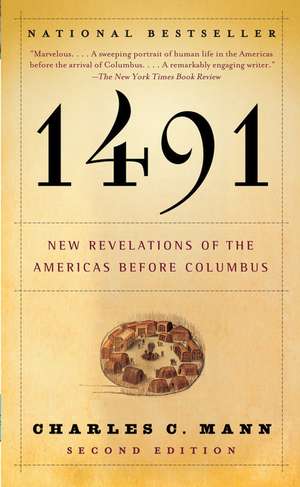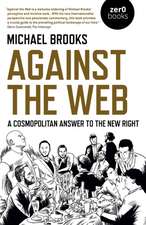1491: New Revelations of the Americas Before Columbus
Autor Charles C. Mannen Limba Engleză Paperback – 30 sep 2006
Contrary to what so many Americans learn in school, the pre-Columbian Indians were not sparsely settled in a pristine wilderness; rather, there were huge numbers of Indians who actively molded and influenced the land around them. The astonishing Aztec capital of Tenochtitlan had running water and immaculately clean streets, and was larger than any contemporary European city. Mexican cultures created corn in a specialized breeding process that it has been called man’s first feat of genetic engineering. Indeed, Indians were not living lightly on the land but were landscaping and manipulating their world in ways that we are only now beginning to understand. Challenging and surprising, this a transformative new look at a rich and fascinating world we only thought we knew.
| Toate formatele și edițiile | Preț | Express |
|---|---|---|
| Paperback (2) | 83.19 lei 3-5 săpt. | +14.04 lei 7-13 zile |
| GRANTA BOOKS – 6 noi 2006 | 83.19 lei 3-5 săpt. | +14.04 lei 7-13 zile |
| Vintage Books USA – 30 sep 2006 | 111.62 lei 3-5 săpt. | +22.41 lei 7-13 zile |
| Hardback (1) | 248.33 lei 3-5 săpt. | |
| Knopf Publishing Group – 31 iul 2005 | 248.33 lei 3-5 săpt. |
Preț: 111.62 lei
Nou
21.36€ • 22.30$ • 17.68£
Carte disponibilă
Livrare economică 14-28 martie
Livrare express 28 februarie-06 martie pentru 32.40 lei
Specificații
ISBN-10: 1400032059
Pagini: 541
Ilustrații: HALFTONES THROUGHOUT
Dimensiuni: 130 x 203 x 33 mm
Greutate: 0.54 kg
Editura: Vintage Books USA
Notă biografică
Charles C. Mann is a correspondent for Science and The Atlantic Monthly, and has co-written four previous books including Noah’s Choice: The Future of Endangered Species and The Second Creation. A three-time National Magazine Award finalist, he has won awards from the American Bar Association, the Margaret Sanger Foundation, the American Institute of Physics, and the Alfred P. Sloan Foundation, among others. His writing was twice selected for both The Best American Science Writing and The Best American Science and Nature Writing. He lives with his wife and their children in Amherst, Massachusetts.
Extras
THE FRIENDLY INDIAN
On March 22, 1621, an official Native American delegation walked through what is now southern New England to negotiate with a group of foreigners who had taken over a recently deserted Indian settlement. At the head of the party was an uneasy triumvirate: Massasoit, the sachem (political-military leader) of the Wampanoag confederation, a loose coalition of several dozen villages that controlled most of what is now southeastern Massachusetts; Samoset, sachem of an allied group to the north; and Tisquantum, a distrusted captive, whom Massasoit had reluctantly brought along as an interpreter.
Massasoit was an adroit politician, but the dilemma he faced would have tested Machiavelli. About five years before, most of his subjects had fallen before a terrible calamity. Whole villages had been depopulated—indeed, the foreigners ahead now occupied one of the empty sites. It was all he could do to hold together the remnants of his people. Adding to his problems, the disaster had not touched the Wampanoag’s longtime enemies, the Narragansett alliance to the west. Soon, Massasoit feared, they would take advantage of the Wampanoag’s weakness and overrun them.
Desperate threats require desperate countermeasures. In a gamble, Massasoit intended to abandon, even reverse, a long-standing policy. Europeans had been visiting New England for at least a century. Shorter than the natives, oddly dressed, and often unbearably dirty, the pallid foreigners had peculiar blue eyes that peeped out of the masks of bristly, animal-like hair that encased their faces. They were irritatingly garrulous, prone to fits of chicanery, and often surprisingly incompetent at what seemed to Indians like basic tasks. But they also made useful and beautiful goods—copper kettles, glittering colored glass, and steel knives and hatchets—unlike anything else in New England. Moreover, they would exchange these valuable items for cheap furs of the sort used by Indians as blankets. It was like happening upon a dingy kiosk that would swap fancy electronic goods for customers’ used socks—almost anyone would be willing to overlook the shopkeeper’s peculiarities.
Over time, the Wampanoag, like other native societies in coastal New England, had learned how to manage the European presence. They encouraged the exchange of goods, but would only allow their visitors to stay ashore for brief, carefully controlled excursions. Those who overstayed their welcome were forcefully reminded of the limited duration of Indian hospitality. At the same time, the Wampanoag fended off Indians from the interior, preventing them from trading directly with the foreigners. In this way the shoreline groups put themselves in the position of classic middlemen, overseeing both European access to Indian products and Indian access to European products. Now Massasoit was visiting a group of British with the intent of changing the rules. He would permit the newcomers to stay for an unlimited time—provided that they formally allied with the Wampanoag against the Narragansett.
Tisquantum, the interpreter, had shown up alone at Massasoit’s home a year and a half before. He spoke fluent English, because he had lived for several years in Britain. But Massasoit didn’t trust him. He seems to have been in Massasoit’s eyes a man without anchor, out for himself. In a conflict, Tisquantum might even side with the foreigners. Massasoit had kept Tisquantum in a kind of captivity since his arrival, monitoring his actions closely. And he refused to use him to negotiate with the colonists until he had another, independent means of communication with them.
That March Samoset—the third member of the triumvirate—appeared, having hitched a ride from his home in Maine on an English ship that was plying the coast. Not known is whether his arrival was due to chance or if Massasoit had asked him to come down because he had picked up a few English phrases by trading with the British. In any case, Massasoit first had sent Samoset, rather than Tisquantum, to the foreigners.
Samoset had walked unaccompanied and unarmed into the circle of rude huts in which the British were living on March 17, 1621. The colonists saw a robust, erect-postured man wearing only a loincloth; his straight black hair was shaved in front but flowed down his shoulders behind. To their further amazement, this almost naked man greeted them in broken but understandable English. He left the next morning with a few presents. A day later he came back, accompanied by five “tall proper men”—the phrase is the colonist Edward Winslow’s—with three-inch black stripes painted down the middle of their faces. The two sides talked inconclusively, each warily checking out the other, for a few hours. Five days later, on the 22nd, Samoset showed up again at the foreigners’ ramshackle base, this time with Tisquantum. Meanwhile Massasoit and the rest of the Indian company waited out of sight.
Samoset and Tisquantum spoke with the colonists for about an hour. Perhaps they then gave a signal. Or perhaps Massasoit was simply following a schedule. In any case, he and the rest of the Indian party appeared without warning at the crest of a hill on the south bank of the creek that ran through Patuxet. Alarmed by Massasoit’s sudden entrance, the settlers withdrew to the hill on the opposite bank, where they had emplaced their few cannons behind a half-finished stockade. A standoff ensued.
Finally Winslow exhibited the decisiveness that later led to his selection as colony governor. Wearing a full suit of armor and carrying a sword, he waded through the stream and offered himself as a hostage. Tisquantum, who walked with him, served as interpreter. Massasoit’s brother took charge of Winslow and then Massasoit crossed the water himself followed by Tisquantum and twenty of Massasoit’s men, all ostentatiously unarmed. The colonists took the sachem to an unfinished house and gave him some cushions to recline on. Both sides shared some of the foreigners’ homemade moonshine, then settled down to talk, Tisquantum translating.
To the colonists, Massasoit could be distinguished from his subjects more by manner than by dress or ornament. He wore the same deerskin shawls and leggings and like his fellows had covered his face with bug-repelling oil and reddish-purple dye. Around his neck hung a pouch of tobacco, a long knife, and a thick chain of the prized white shell beads called wampum. In appearance, Winslow wrote afterward, he was “a very lusty man, in his best years, an able body, grave of countenance, and spare of speech.” The Europeans, who had barely survived the previous winter, were in much worse shape. Half of the original colony now lay underground beneath wooden markers painted with death’s heads; most of the survivors were malnourished.
Their meeting was a critical moment in American history. The foreigners called their colony Plymouth; they themselves were the famous Pilgrims.* As schoolchildren learn, at that meeting the Pilgrims obtained the services of Tisquantum, usually known as “Squanto.” In the 1970s, when I attended high school, a popular history text was America: Its People and Values, by Leonard C. Wood, Ralph H. Gabriel, and Edward L. Biller. Nestled among colorful illustrations of colonial life was a succinct explanation of Tisquantum’s role:
A friendly Indian named Squanto helped the colonists. He showed them how to plant corn and how to live on the edge of the wilderness. A soldier, Captain Miles Standish, taught the Pilgrims how to defend themselves against unfriendly Indians.
My teacher explained that maize was unfamiliar to the Pilgrims and that Tisquantum had demonstrated the proper maize-planting technique—sticking the seed in little heaps of dirt, accompanied by beans and squash that would later twine themselves up the tall stalks. And he told the Pilgrims to fertilize the soil by burying fish alongside the maize seeds, a traditional native technique for producing a bountiful harvest. Following this advice, my teacher said, the colonists grew so much maize that it became the centerpiece of the first Thanksgiving. In our slipshod fashion, we students took notes.
The story in America: Its People and Values isn’t wrong, so far as it goes. But the impression it gives is entirely misleading.
Tisquantum was critical to the colony’s survival, contemporary scholars agree. He moved to Plymouth after the meeting and spent the rest of his life there. Just as my teacher said, Tisquantum told the colonists to bury several small fish in each maize hill, a procedure followed by European settlers for the next two centuries. Squanto’s teachings, Winslow concluded, led to “a good increase of Indian corn”—the difference between success and starvation.
Winslow didn’t know that fish fertilizer may not have been an age-old Indian custom, but a recent invention—if it was an Indian practice at all. So little evidence has emerged of Indians fertilizing with fish that some archaeologists believe that Tisquantum actually picked up the idea from European farmers. The notion is not as ridiculous as it may seem. Tisquantum had learned English because British sailors had kidnapped him seven years before. To return to the Americas, he in effect had to escape twice—once from Spain, where his captors initially sold him into slavery, and once from England, to which he was smuggled from Spain, and where he served as a kind of living conversation piece at a rich man’s house. In his travels, Tisquantum stayed in places where Europeans used fish as fertilizer, a practice on the Continent since medieval times.
Skipping over the complex course of Tisquantum’s life is understandable in a textbook with limited space. But the omission is symptomatic of the complete failure to consider Indian motives, or even that Indians might have motives. The alliance Massasoit negotiated with Plymouth was successful from the Wampanoag perspective, for it helped to hold off the Narragansett. But it was a disaster from the point of view of New England Indian society as a whole, for the alliance ensured the survival of Plymouth colony, which spearheaded the great wave of British immigration to New England. All of this was absent not only from my high school textbooks, but from the academic accounts they were based on.
This variant of Holmberg’s Mistake dates back to the Pilgrims themselves, who ascribed the lack of effective native resistance to the will of God. “Divine providence,” the colonist Daniel Gookin wrote, favored “the quiet and peaceable settlement of the English.” Later writers tended to attribute European success not to European deities but to European technology. In a contest where only one side had rifles and cannons, historians said, the other side’s motives were irrelevant. By the end of the nineteenth century, the Indians of the Northeast were thought of as rapidly fading background details in the saga of the rise of the United States—“marginal people who were losers in the end,” as James Axtell of the College of William and Mary dryly put it in an interview. Vietnam War–era denunciations of the Pilgrims as imperialist or racist simply replicated the error in a new form. Whether the cause was the Pilgrim God, Pilgrim guns, or Pilgrim greed, native losses were foreordained; Indians could not have stopped colonization, in this view, and they hardly tried.
Beginning in the 1970s, Axtell, Neal Salisbury, Francis Jennings, and other historians grew dissatisfied with this view. “Indians were seen as trivial, ineffectual patsies,” Salisbury, a historian at Smith College, told me. “But that assumption—a whole continent of patsies—simply didn’t make sense.” These researchers tried to peer through the colonial records to the Indian lives beneath. Their work fed a tsunami of inquiry into the interactions between natives and newcomers in the era when they faced each other as relative equals. “No other field in American history has grown as fast,” marveled Joyce Chaplin, a Harvard historian, in 2003.
The fall of Indian societies had everything to do with the natives themselves, researchers argue, rather than being religiously or technologically determined. (Here the claim is not that indigenous cultures should be blamed for their own demise but that they helped to determine their own fates.) “When you look at the historical record, it’s clear that Indians were trying to control their own destinies,” Salisbury said. “And often enough they succeeded”—only to learn, as all peoples do, that the consequences were not what they expected.
This chapter and the next will explore how two different Indian societies, the Wampanoag and the Inka, reacted to the incursions from across the sea. It may seem odd that a book about Indian life before contact should devote space to the period after contact, but there are reasons for it. First, colonial descriptions of Native Americans are among the few glimpses we have of Indians whose lives were not shaped by the presence of Europe. The accounts of the initial encounters between Indians and Europeans are windows into the past, even if the glass is smeared and distorted by the chroniclers’ prejudices and misapprehensions.
Second, although the stories of early contact—the Wampanoag with the British, the Inka with the Spanish—are as dissimilar as their protagonists, many archaeologists, anthropologists, and historians have recently come to believe that they have deep commonalities. And the tales of other Indians’ encounters with the strangers were alike in the same way. From these shared features, researchers have constructed what might be thought of as a master narrative of the meeting of Europe and America. Although it remains surprisingly little known outside specialist circles, this master narrative illuminates the origins of every nation in the Americas today. More than that, the effort to understand events after Columbus shed unexpected light on critical aspects of life before Columbus. Indeed, the master narrative led to such surprising conclusions about Native American societies before the arrival of Europeans that it stirred up an intellectual firestorm.
COMING OF AGE IN THE DAWNLAND
Consider Tisquantum, the “friendly Indian” of the textbook. More than likely Tisquantum was not the name he was given at birth. In that part of the Northeast, tisquantum referred to rage, especially the rage of manitou, the world-suffusing spiritual power at the heart of coastal Indians’ religious beliefs. When Tisquantum approached the Pilgrims and identified himself by that sobriquet, it was as if he had stuck out his hand and said, Hello, I’m the Wrath of God. No one would lightly adopt such a name in contemporary Western society. Neither would anyone in seventeenth-century indigenous society. Tisquantum was trying to project something.
Tisquantum was not an Indian. True, he belonged to that category of people whose ancestors had inhabited the Western Hemisphere for thousands of years. And it is true that I refer to him as an Indian, because the label is useful shorthand; so would his descendants, and for much the same reason. But “Indian” was not a category that Tisquantum himself would have recognized, any more than the inhabitants of the same area today would call themselves “Western Hemisphereans.” Still less would Tisquantum have claimed to belong to “Norumbega,” the label by which most Europeans then referred to New England. (“New England” was coined only in 1616.) As Tisquantum’s later history made clear, he regarded himself first and foremost as a citizen of Patuxet, a shoreline settlement halfway between what is now Boston and the beginning of Cape Cod.
Patuxet was one of the dozen or so settlements in what is now eastern Massachusetts and Rhode Island that comprised the Wampanoag confederation. In turn, the Wampanoag were part of a tripartite alliance with two other confederations: the Nauset, which comprised some thirty groups on Cape Cod; and the Massachusett, several dozen villages clustered around Massachusetts Bay. All of these people spoke variants of Massachusett, a member of the Algonquian language family, the biggest in eastern North America at the time. (Massachusett was the name both of a language and of one of the groups that spoke it.) In Massachusett, the name for the New England shore was the Dawnland, the place where the sun rose. The inhabitants of the Dawnland were the People of the First Light.
Recenzii
—The New York Review of Books
“Marvelous. . . . A sweeping portrait of human life in the Americas before the arrival of Columbus. . . . A remarkably engaging writer.”
—The New York Times Book Review
“Fascinating. . . . A landmark of a book that drops ingrained images of colonial American into the dustbin, one after the other.”
—The Boston Globe
“A ripping, man-on-the-ground tour of a world most of us barely intuit. . . . An exhilarating shift in perspective. . . . 1491 erases our myth of a wilderness Eden. It replaces that fallacy with evidence of a different genesis, exciting and closer to true.”
—The Cleveland Plain Dealer
“Mann tells a powerful, provocative and important story. . . . 1491 vividly compels us to re-examine how we teach the ancient history of the Americas and how we live with the environmental consequences of colonization.”
—The Washington Post Book World
“Engagingly written and utterly absorbing. . . . Part detective story, part epic and part tragedy.”
—The Miami Herald
“Provocative. . . . A Jared Diamond-like volley that challenges prevailing thinking about global development. Mann has chronicled an important shift in our vision of world development, one out young children could end up studying in their text books when they reach junior high.”
—San Francisco Chronicle
“Marvelous. . . . A revelation. . . . Our concept of pure wilderness untouched by grubby human hands must now be jettisoned.”
—The New York Sun
“Monumental. . . . Mann slips in so many fresh, new interpretations of American history that it all adds up to a deeply subversive work.”
—Salon
“Concise and brilliantly entertaining. . . . Reminiscent of John McPhee's eloquence with scientific detail.”
—Los Angeles Times
Cuprins
List of Maps
PrefaceINTRODUCTION / Holmberg’s Mistake
1. A View from Above
PART ONE / Numbers from Nowhere?
2. Why Billington Survived
3. In the Land of Four Quarters
4. Frequently Asked Questions
PART TWO / Very Old Bones
5. Pleistocene Wars
6. Cotton (or Anchovies) and Maize (Tales of Two Civilizations, Part I)
7. Writing, Wheels, and Bucket Brigades (Tales of Two Civilizations, Part II)
PART THREE / Landscape with Figures
8. Made in America
9. Amazonia
10. The Artificial Wilderness
11. The Great Law of Peace
Appendixes
A. Loaded Words
B. Talking Knots
C. The Syphilis Exception
D. Calendar Math
Acknowledgments
Notes
Bibliography
Index
From the Hardcover edition.
Descriere
In this groundbreaking work of science, history, and archaeology, Charles C. Mann radically alters our understanding of the Americas before the arrival of Columbus in 1492.
Contrary to what so many Americans learn in school, the pre-Columbian Indians were not sparsely settled in a pristine wilderness; rather, there were huge numbers of Indians who actively molded and influenced the land around them. The astonishing Aztec capital of Tenochtitlan had running water and immaculately clean streets, and was larger than any contemporary European city. Mexican cultures created corn in a specialized breeding process that it has been called man’s first feat of genetic engineering. Indeed, Indians were not living lightly on the land but were landscaping and manipulating their world in ways that we are only now beginning to understand. Challenging and surprising, this a transformative new look at a rich and fascinating world we only thought we knew.
























